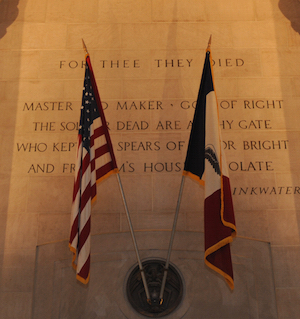
AMES, Iowa – In a Veterans Day observance, Iowa State University will honor alumnus Walter Wilson from Lake City, who died on a bombing mission in World War II.
Iowa State will recognize Wilson and two other former students who died in military service during the Gold Star Hall Ceremony, 3:15 p.m. Monday, Nov. 9, in the Memorial Union Great Hall. It is free and open to the public.
Former students are eligible for name placement in the Gold Star Hall — the war memorial in the university's Memorial Union — if they graduated from or attended Iowa State full time for one or more semesters, and died while in military service in a war zone. As names become known, they are added to the wall and the soldiers are remembered in the university's annual ceremony.
Although Wilson's name was previously engraved on the memorial wall, he has not been honored in a ceremony. Iowa State is able to memorialize Wilson this year with help and materials from his sister Marjorie Webster, Bergenfield, New Jersey; Wilson's wife Pauline Noren, Rapid City, South Dakota; and his daughter Carol Marie Wilson Heiden, Nuremberg, Germany.
Wilson family members visited the ISU Memorial Union last year to see Walter's name engraved on the wall of fallen soldiers in the Gold Star Hall. They connected with Memorial Union staff and agreed to share his story and return to Ames this year for the ceremony. Among those attending on Nov. 9 will be Webster, Noren, Wilson Heiden and several additional family members.
A life remembered
Walter Wilson was born on Aug. 18, 1918, in Paton to Melvin Wilson and Mary White Wilson. He grew up in Lake City with five siblings. In high school, he was involved in athletics, class plays, orchestra and band. Wilson was president of his sophomore class and treasurer of his senior class.
In 1937, Wilson started his studies at Iowa State, where he majored in industrial economics. He was involved in the Bomb yearbook staff, debate, Veishea, Ward Executive Council and intramurals. After graduation in 1941, he moved to California for a post-graduate course in aeronautical engineering at Curtiss-Wright Technical Institute and was hired by Lockheed Corporation.

Wilson enlisted in the Army Air Force in September 1942 and, in October, married Pauline (Polly) Noren, whom he had met at Iowa State. He entered service at Boca Raton, Florida, in June 1943, about the time his daughter Carol Marie was born.
In February 1944, Wilson was commissioned as a second lieutenant in New Haven, Connecticut. He trained at Yale University Army Air Force as a maintenance engineer, the Boeing B-29 factory school and the Army Air Force Light Engineer School, Lowry Field, Colorado.
Wilson was 16 years older than his youngest sister Marjorie, who "vividly" recalls the last time she saw him.
"He was leaving Lake City to be stationed in New Mexico. He took me to the little grade school where I was in third or fourth grade. We stood outside the door where the steps were that would take me to my classroom. He hugged me and kissed me, and I cried. Little did I know that that would be the last time I would see him alive," Webster said.
Promoted in May 1945 to first lieutenant, Wilson was then stationed in the South Pacific at Tinian as a flight engineer on a B-29 Superfortress in the 20th Air Force, 444th Bomb Group, 677 Bomb Squad.
On July 24, 1945, the 444th was assigned mission 284: 82 58th-Bombardment Wing B-29s were to attack the Sumitomo Light Metals Industries propeller factory at Osaka. The daylight mission at 19,500 feet was a full-scale attack against heavy opposition. A total of 115 4,000-pound bombs destroyed 85 percent of the target. Wilson’s B-29 received a direct hit by anti-aircraft flak and broke in two, crashing into Osaka Bay. There were no survivors. Of the 82 planes in the raid on Sumitomo Works, Wilson’s B-29 was the only one lost that day.
Webster remembers the day well:
"On July 24, 1945, my parents, my sister Marion and I were in the car headed to Marshalltown, to visit friends. The car radio was on WHO, and the news broadcaster announced that a squadron of B-29s flew over Osaka, Japan, on a bombing mission and one was hit by flak and went down into Osaka Bay, one of the deepest bays in the world. My dad said to my mom, 'Mother, that could have been Walter’s plane.' Walter was a flight engineer on a B-29, and, yes, we later learned, it was his plane," she said.
"My sister-in-law, Polly, received word on Aug.14, 1945, that Walter was missing in action — the day that the war with Japan ended. She called my parents the same day. Everyone else was out celebrating the end of the war, and our family was shedding tears of fear that the young men in that B-29 were lost forever."
Wilson was 26 when he died in battle. After his death, he was awarded the Air Medal with Oak Leaf Cluster and the Purple Heart.
